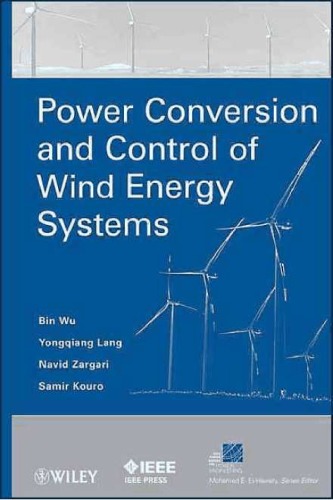

Most ebook files are in PDF format, so you can easily read them using various software such as Foxit Reader or directly on the Google Chrome browser.
Some ebook files are released by publishers in other formats such as .awz, .mobi, .epub, .fb2, etc. You may need to install specific software to read these formats on mobile/PC, such as Calibre.
Please read the tutorial at this link. https://ebooknice.com/page/post?id=faq
We offer FREE conversion to the popular formats you request; however, this may take some time. Therefore, right after payment, please email us, and we will try to provide the service as quickly as possible.
For some exceptional file formats or broken links (if any), please refrain from opening any disputes. Instead, email us first, and we will try to assist within a maximum of 6 hours.
EbookNice Team

Status:
Available5.0
41 reviews
ISBN 10: 1118029003
ISBN 13: 9781118029008
Author: Bin Wu, Yongqiang Lang, Navid Zargari, Samir Kouro
The book presents the latest power conversion and control technology in modern wind energy systems. It has nine chapters, covering technology overview and market survey, electric generators and modeling, power converters and modulation techniques, wind turbine characteristics and configurations, and control schemes for fixed- and variable-speed wind energy systems. The book also provides in-depth steady-state and dynamic analysis of squirrel cage induction generator, doubly fed induction generator, and synchronous generator based wind energy systems.
To illustrate the key concepts and help the reader tackle real-world issues, the book contains more than 30 case studies and 100 solved problems in addition to simulations and experiments. The book serves as a comprehensive reference for academic researchers and practicing engineers. It can also be used as a textbook for graduate students and final year undergraduate students.
1. Introduction.
1.1 Introduction.
1.2 Overview of Wind Energy Conversion Systems.
1.3 Wind Turbine Technology.
1.4 Wind Energy Conversion System Configurations.
1.5 Grid Code.
1.6 Summary.
2. Fundamentals of Wind Energy Conversion System Control.
2.1 Introduction.
2.2 Wind Turbine Components.
2.3 Wind Turbine Aerodynamics.
2.4 Maximum Power Point Tracking (MPPT) Control.
2.5 Summary.
3. Wind Generators and Modeling.
3.1 Introduction.
3.2 Reference Frame Transformation.
3.3 Induction Generator Models.
3.4 Synchronous Generators.
3.5 Summary.
4. Power Converters in Wind Energy Conversion Systems.
4.1 Introduction.
4.2 AC Voltage Controllers (Soft Starters).
4.3 Interleaved Boost Converters.
4.4 Two-Level Voltage Source Converters.
4.5 Three-Level Neutral Point Clamped Converters.
4.6 PWM Current Source Converters.
4.7 Control of Grid-Connected Inverter.
4.8 Summary.
5. Wind Energy System Configurations.
5.1 Introduction.
5.2 Fixed Speed WECS.
5.3 Variable Speed Induction Generator WECS.
5.4 Variable-speed Synchronous Generator WECS.
5.5 Summary.
6. Fixed-Speed Induction Generator WECS.
6.1 Introduction.
6.2 Configuration of Fixed-Speed Wind Energy Systems.
6.3 Operation Principle.
6.4 Grid Connection with Soft Starter.
6.5 Reactive Power Compensation.
6.6 Summary.
7. Variable-Speed Wind Energy Systems with Squirrel Cage Induction Generators.
7.1 Introduction.
7.2 Direct Field Oriented Control.
7.3 Indirect Field Oriented Control.
7.4 Direct Torque Control.
7.5 Control of Current Source Converter Interfaced WECS.
7.6 Summary.
8. Doubly-Fed Induction Generator Based WECS.
8.1 Introduction.
8.2 Super- and Sub-synchronous Operation of DFIG.
8.3 Unity Power Factor Operation of DFIG.
8.4 Leading and Lagging Power Factor Operation.
8.5 A Steady-State Performance of DFIG WECS.
8.6 DFIG WECS Start-up and Experiments.
8.7 Summary.
9. Variable-Speed Wind Energy Systems with Synchronous Generators.
9.1 Introduction.
9.2 System Configuration.
9.3 Control of Synchronous Generators.
9.4 SG Wind Energy System with Back-to-back VSC.
9.5 DC/DC Boost Converter Interfaced SG Wind Energy Systems.
9.6 Reactive Power Control of SG WECS.
9.7 Current Source Converter Based SG Wind Energy Systems.
9.8 Summary.
Tags: Bin Wu, Yongqiang Lang, Navid Zargari, Samir Kouro, conversion, control